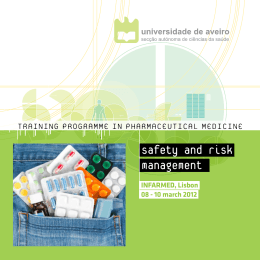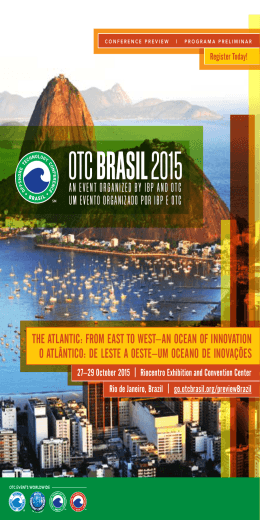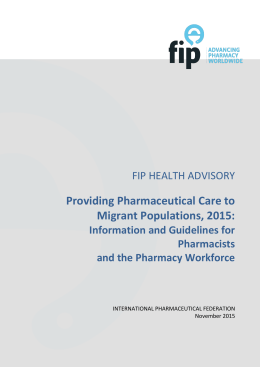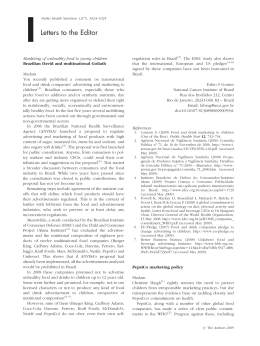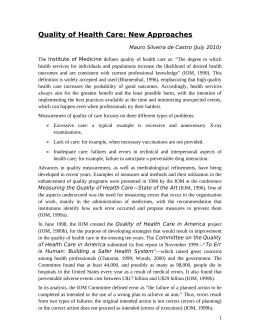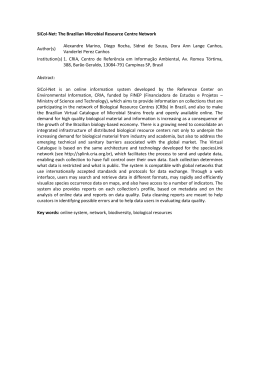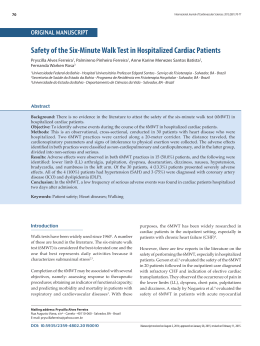ADVERSE EVENT REPORTS ABOUT OVER-THE-COUNTER DRUGS IN BRAZIL 1 MILENA OLIVEIRA BITTENCOURT , LAÍS FÁTIMA DE SOUZA FRANÇA, LEANDRO ALVES MACEDO DA SILVA, MURILO FREITAS DIAS BRAZILIAN HEALTH SURVEILLANCE AGENCY - ANVISA/ CENTER FOR SURVEILLANCE OF ADVERSE EVENTS AND QUALITY DEVIATIONS - NUVIG/ PHARMACOVIGILANCE OFFICE - GFARM/ BRAZIL 1 [email protected] Background: Brazilian Pharmacovigilance has been developed, at Federal level, since November 1999, through the Brazilian Health Surveillance Agency (ANVISA). In the year 2001, Decree n. 696, of the Ministry of Health, created the Brazilian Medicine Monitoring Centre (CNMM), placed in the Pharmacovigilance Unit, which allowed the insertion of Brazil as the 62nd country in the International Drug Monitoring Programme of the World Health Organization (WHO), coordinated by the Uppsala Monitoring Centre, in Sweden, a WHO Collaborative Centre. In October 2005, Pharmacovigilance Unit was internally inserted into the Center for Surveillance of Adverse Events and Quality Deviations, which attributions include proposing, planning, coordinating and establishing the national subsystem of health surveillance for post-marketing products used in humans for diagnosis or therapy, including medicines. Adverse event reports have been received mainly by electronic reporting forms, available at http://www.anvisa.gov.br/servicos/ Form/farmaco/index.htm. The reports can also be sent by e-mail, fax, telephone and mail. According to adverse event type, the majority of reports were about drug adverse reactions (49,8%), followed by quality deviations (substandard products) (45,4%). From 445 adverse reaction reports about OTC drugs received, pharmacists contributed with 54,6% of reports. OTC drug quality deviations reports were also sent mainly by pharmacists (69,6%). From 35 OTC drug therapeutic ineffectiveness reports received by CNMM, the majority were sent by consumers (45,7%). The other adverse event types medication error and drug intoxication corresponded to 8 reports (0,9%). (Fig. 3) Fig. 3. Percentage of adverse event reports about OTC drugs received by CNMM, according to event type, from November 1999 to October 2006. Quality deviantion (substandard product) reports about OTC drugs according to professional categories (N = 405) Drug therapeutic ineffectiveness reports about OTC drugs according to professional categories (N = 35) 11,43% (n=4) 5,93 % (n=24) 8,15 % (n=33) 5,71% (n=2) 45,71% (n=16) 69,63 % (n=282) Ove rall adverse event re ports about OTC drugs according to event type (N = 893) Pharmacists Pharmacists Physicians In Brazil, over-the-counter (OTC) drug commercialization is regulated by Decree n. 138 published in June, 2003. This Decree is now being reviewed by Brazilian Health Surveillance Agency (Anvisa). A working group was formed to evaluate safety and effectiveness of each active principle belonging to OTC drug therapeutic classes. This evaluation must be supported by drug complete information, toxicologic and adverse event data, among other evidences. 3,92 % (n=35) Not informed Not inf ormed To describe adverse events about OTC drugs spontaneously reported to Brazilian Medicine Monitoring Centre (CNMM) from November 1999 to October 2006. Methods: Consumers Physicians Nurses Others 0,90 % (n=8) 49,83 % (n=445) 45,35 % (n=445) ADR reports about OTC drugs according to professional categories (N = 445) Adverse drug reaction (ADR) Quality deviation Therapeutic inef fectiveness Others (medication error, drug intoxication) 7,42 % (n=33) 9,89 % (n=44) 1,12 % (n=5) 13,48 % (n=60) 54,61 % (n=243) 13,48 % (n=60) Pharmacists Objectives: 0,25% (n=1) 12,35 % (n=50) 37,14% (n=13) Consumers 3,70 % (n=15) Physicians Not informed Consumers Nurses Dentists Evaluating adverse event report rates between pharmacists and physicians: - related to all adverse events about OTC drugs, pharmacists have contributed to 6 times more reports than physicians; - related specifically to serious adverse events about OTC drugs, pharmacists have contributed to 2 times more reports than physicians. Only reports containing OTC drug as a suspected drug were evaluated. They were evaluated according to reporting professional category, and adverse event seriousness and event type (adverse drug reaction, quality deviation, drug therapeutic ineffectiveness and others). Evaluating adverse event report rates between pharmacists and consumers, the results were: - related to all adverse events about OTC drugs, pharmacists have contributed to 5,5 times more reports than consumers; and - related specifically to drug therapeutic ineffectiveness about OTC drugs, consumers have contributed to 1,2 times more reports than pharmacists. Results: Major limitations of this study: From 9,279 total reports received, 893 (9,6%) were about OTC drugs. Pharmacists were the most frequent reporting professionals (60,2%) (Fig. 1). Related to CNMM database: • Those described for spontaneous reporting system (like underreporting, OTC drug exposure unknown). • Most reports received by CNMM were from sentinel hospital network, which includes 190 hospitals nationwide which use more hospitalar drugs. • Database is still being consolidated. Fig. 1. Percentage of adverse event reports about OTC drugs received by CNMM from November 1999 to October 2006. Overall adverse event reports (N = 9,279) 9,62 % (n=893) Related to the research: • Contradictory informations about drug market status in Anvisa´s database (DATAVISA). • Lack of an OTC drug active principle list. Adverse event reports about OTC drugs according to professional categories (N = 893) 5,38% 0,67% (n=48) (n=6) 9,85% (n=88) 10,86% (n=97) Conclusion: 60,25% (n=538) 12,99% (n=116) 90,38 % (n=8386) OTC drugs POM drugs Pharmacists Not informed Consumers Nurses Physicians Dentists/Others (less than 1%) Serious adverse events were present in 151 reports (16,9%); most of these were reported by pharmacists (53,0%). (Fig. 2) Fig. 2. Percentage of adverse event reports about OTC drugs received by CNMM, according to seriousness, from November 1999 to October 2006. Overall adverse event reports about OTC drugs (N = 893) 16,91 % (n=151) 83,09 % (n=742) Serious Serious adverse event reports about OTC drugs according to professional categories (N = 151) 6,62 % 5,96 % 7,95 %(n=10) (n=9) (n=12) 52,98 % (n=80) 26,49 % (n=40) Non-serious Pharmacists Physicians Not informed Consumers Nurses Considering the results achieved, pharmacists are the most contributor professionals for OTC drug pharmacovigilance in Brazil. They have not only highly contributed to overall adverse event reports (60%) but also contributed with most of serious adverse event reports (53%). Pharmacists must be continually sensitized about reporting OTC adverse events. In 2005 it was created a Reporting Pharmacy Program, to enable pharmacists how to detect, identify and report adverse events. This program is being nationally implemented, with participation of 14 States until now in almost 3,000 pharmacies. Other strategies are being planned by CNMM to sensitize physicians and consumers about reporting OTC adverse events, such as partnerships with medical associations and with consumer organizations.
Download
